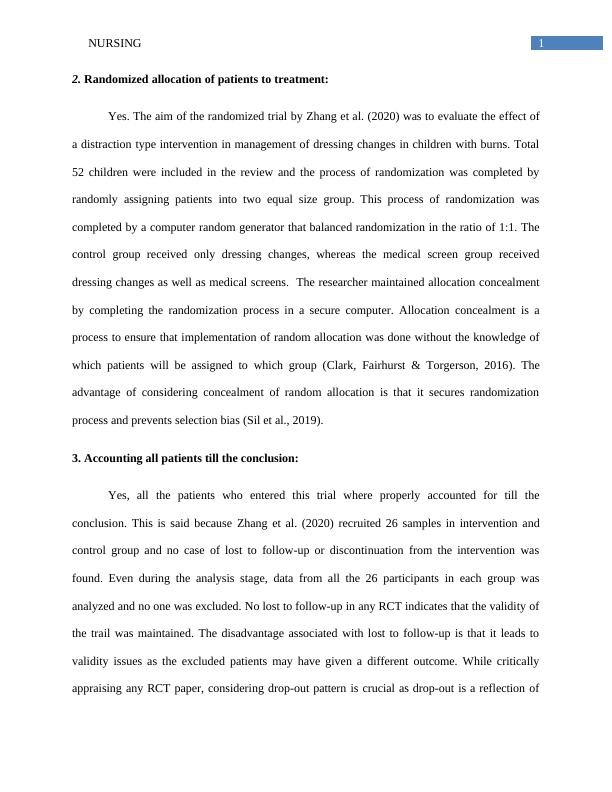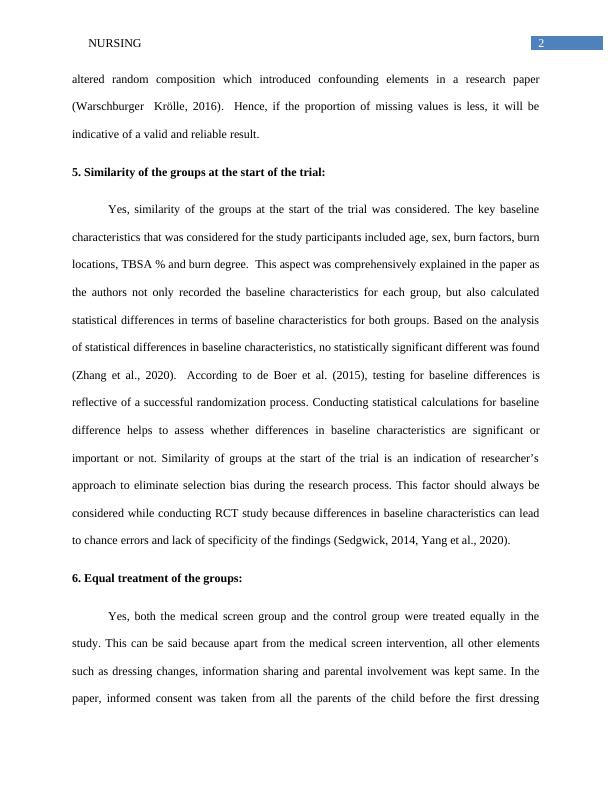Randomized allocation of patients to treatment
Added on 2022-09-15
8 Pages2337 Words39 Views
Running head: NURSING
Nursing
Name of the student:
Name of the University:
Author’s note
Nursing
Name of the student:
Name of the University:
Author’s note

1NURSING
2. Randomized allocation of patients to treatment:
Yes. The aim of the randomized trial by Zhang et al. (2020) was to evaluate the effect of
a distraction type intervention in management of dressing changes in children with burns. Total
52 children were included in the review and the process of randomization was completed by
randomly assigning patients into two equal size group. This process of randomization was
completed by a computer random generator that balanced randomization in the ratio of 1:1. The
control group received only dressing changes, whereas the medical screen group received
dressing changes as well as medical screens. The researcher maintained allocation concealment
by completing the randomization process in a secure computer. Allocation concealment is a
process to ensure that implementation of random allocation was done without the knowledge of
which patients will be assigned to which group (Clark, Fairhurst & Torgerson, 2016). The
advantage of considering concealment of random allocation is that it secures randomization
process and prevents selection bias (Sil et al., 2019).
3. Accounting all patients till the conclusion:
Yes, all the patients who entered this trial where properly accounted for till the
conclusion. This is said because Zhang et al. (2020) recruited 26 samples in intervention and
control group and no case of lost to follow-up or discontinuation from the intervention was
found. Even during the analysis stage, data from all the 26 participants in each group was
analyzed and no one was excluded. No lost to follow-up in any RCT indicates that the validity of
the trail was maintained. The disadvantage associated with lost to follow-up is that it leads to
validity issues as the excluded patients may have given a different outcome. While critically
appraising any RCT paper, considering drop-out pattern is crucial as drop-out is a reflection of
2. Randomized allocation of patients to treatment:
Yes. The aim of the randomized trial by Zhang et al. (2020) was to evaluate the effect of
a distraction type intervention in management of dressing changes in children with burns. Total
52 children were included in the review and the process of randomization was completed by
randomly assigning patients into two equal size group. This process of randomization was
completed by a computer random generator that balanced randomization in the ratio of 1:1. The
control group received only dressing changes, whereas the medical screen group received
dressing changes as well as medical screens. The researcher maintained allocation concealment
by completing the randomization process in a secure computer. Allocation concealment is a
process to ensure that implementation of random allocation was done without the knowledge of
which patients will be assigned to which group (Clark, Fairhurst & Torgerson, 2016). The
advantage of considering concealment of random allocation is that it secures randomization
process and prevents selection bias (Sil et al., 2019).
3. Accounting all patients till the conclusion:
Yes, all the patients who entered this trial where properly accounted for till the
conclusion. This is said because Zhang et al. (2020) recruited 26 samples in intervention and
control group and no case of lost to follow-up or discontinuation from the intervention was
found. Even during the analysis stage, data from all the 26 participants in each group was
analyzed and no one was excluded. No lost to follow-up in any RCT indicates that the validity of
the trail was maintained. The disadvantage associated with lost to follow-up is that it leads to
validity issues as the excluded patients may have given a different outcome. While critically
appraising any RCT paper, considering drop-out pattern is crucial as drop-out is a reflection of

2NURSING
altered random composition which introduced confounding elements in a research paper
(Warschburger Krölle, 2016). Hence, if the proportion of missing values is less, it will be
indicative of a valid and reliable result.
5. Similarity of the groups at the start of the trial:
Yes, similarity of the groups at the start of the trial was considered. The key baseline
characteristics that was considered for the study participants included age, sex, burn factors, burn
locations, TBSA % and burn degree. This aspect was comprehensively explained in the paper as
the authors not only recorded the baseline characteristics for each group, but also calculated
statistical differences in terms of baseline characteristics for both groups. Based on the analysis
of statistical differences in baseline characteristics, no statistically significant different was found
(Zhang et al., 2020). According to de Boer et al. (2015), testing for baseline differences is
reflective of a successful randomization process. Conducting statistical calculations for baseline
difference helps to assess whether differences in baseline characteristics are significant or
important or not. Similarity of groups at the start of the trial is an indication of researcher’s
approach to eliminate selection bias during the research process. This factor should always be
considered while conducting RCT study because differences in baseline characteristics can lead
to chance errors and lack of specificity of the findings (Sedgwick, 2014, Yang et al., 2020).
6. Equal treatment of the groups:
Yes, both the medical screen group and the control group were treated equally in the
study. This can be said because apart from the medical screen intervention, all other elements
such as dressing changes, information sharing and parental involvement was kept same. In the
paper, informed consent was taken from all the parents of the child before the first dressing
altered random composition which introduced confounding elements in a research paper
(Warschburger Krölle, 2016). Hence, if the proportion of missing values is less, it will be
indicative of a valid and reliable result.
5. Similarity of the groups at the start of the trial:
Yes, similarity of the groups at the start of the trial was considered. The key baseline
characteristics that was considered for the study participants included age, sex, burn factors, burn
locations, TBSA % and burn degree. This aspect was comprehensively explained in the paper as
the authors not only recorded the baseline characteristics for each group, but also calculated
statistical differences in terms of baseline characteristics for both groups. Based on the analysis
of statistical differences in baseline characteristics, no statistically significant different was found
(Zhang et al., 2020). According to de Boer et al. (2015), testing for baseline differences is
reflective of a successful randomization process. Conducting statistical calculations for baseline
difference helps to assess whether differences in baseline characteristics are significant or
important or not. Similarity of groups at the start of the trial is an indication of researcher’s
approach to eliminate selection bias during the research process. This factor should always be
considered while conducting RCT study because differences in baseline characteristics can lead
to chance errors and lack of specificity of the findings (Sedgwick, 2014, Yang et al., 2020).
6. Equal treatment of the groups:
Yes, both the medical screen group and the control group were treated equally in the
study. This can be said because apart from the medical screen intervention, all other elements
such as dressing changes, information sharing and parental involvement was kept same. In the
paper, informed consent was taken from all the parents of the child before the first dressing

End of preview
Want to access all the pages? Upload your documents or become a member.
Related Documents
Report on Randomised Control Triallg...
|9
|2361
|64
Critical Appraisal of Ohura et al. (2011) Randomized Controlled Triallg...
|9
|2204
|455
Module 4 Discussion 13 Randomized Controlled Trial Assignment 2022lg...
|5
|514
|15
Quantitative Research on Non-Therapeutic Intervention for Fibromyalgia Patientslg...
|13
|4544
|47
Evidence Based Nursing Research 2022lg...
|9
|2541
|23
Critical Appraisal of Articlelg...
|10
|2111
|232
